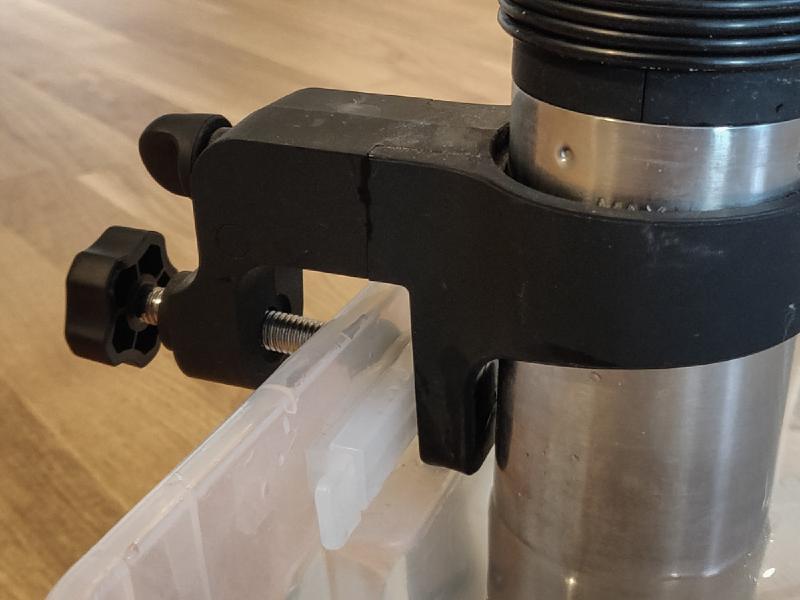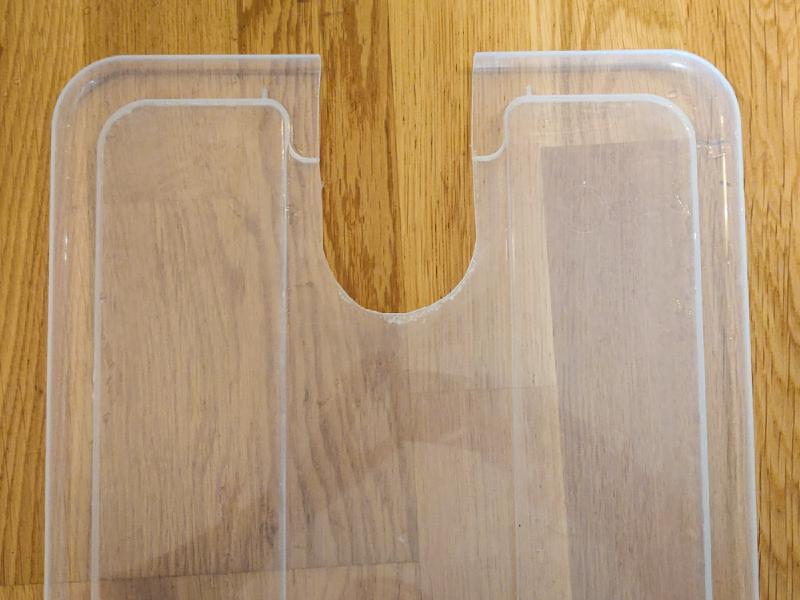Since acquiring an Anova sous-vide cooker, it has become an essential component of my weekly cooking routine. Their marketing materials show the device being used in any large pot you probably already have. This is fine for occasional use, but since I use the device frequently I started looking for a dedicated vessel.
A dedicated vessel also lets you cook a larger quantity of food, or something awkwardly large like a rack of ribs. You can buy a pre-built container but it costs $70 and is not insulated. So I decided to build a simple dedicated container that was semi-insulated, so that it would be energy efficient when cooking ribs for 48 hours.
What you’ll need
Consumable supplies
| Item | Cost |
|---|---|
| SAMLA box (with lid) from IKEA | $3 |
| Cheap blanket (x2) | $4 |
| Small plastic clamps (x2) | $2 |
| Hot glue | $1 |
| Total | $10 |
Tools
- A reasonably powerful power drill
- 60mm hole saw bit – You’ll want this to match the diameter of your sous-vide unit as closely as possible so that it fits in snugly. My Anova unit (original version) needed a ~62mm hole, so I used a 60mm bit and sanded it down until it fit. If you are using a newer version, check the diameter of your unit.
- Hack saw – To make cuts between the circular hole and the edge of the plastic lid.
- Sandpaper – To smooth any uneven plastic edges.
How to build it
Glue a support to the box
The lip of the SAMLA box is a bit flimsy, so you’ll probably want to glue something on to reinforce it. I used a a transluscent plastic bag clip that was nearby in the kitchen. You’ll want to do this first, since this affects the position of the clamp, which determines where you should drill the hole in the lid.

Cut a hole in the lid
- Attach the sous-vide clamp to the container and mark the center of the hole on the plastic lid.
- Attach the lid firmly to the box, and use the hole saw attachment on a drill to make a cut at the marked point.
- Use the hacksaw to extend the cuts from both sides of the hole to the edge of the lid.
- Use sandpaper to slightly enlarge the hole until it fits your Anova device, and also to smooth off any rough edges from the hacksaw.

Wrap with towels
- Fold the towels into long thin strips.
- Wrap one snuggly around the sides and use plastic clamps to attach at the back
- Fold the other in such a way that it covers the entire lid, tucking around sous-vide clamp.
I tried two ways shown below to fold the top blanket. A simple square fold (left) looks nicer, but it leaves the lid around the sous-vide unit itself uninsulated. Folding a long thin towel (right) to cover the entire lid looks a bit messier, but is more energy efficient (~10 watts).

Easier

More efficient (slightly)
For even larger cooks
If you are cooking something even larger (or a large quantity for a dinner party) you can also buy the larger 6-gallon SAMLA box which uses the same size lid.
Update [2020-05-01]:
If I were doing this again from scratch, I would probably opt for the newer IKEA 365+ tupperware containers. The lid is more securely attached than the SAMLA, so you could do just the hole saw cut and let the sous-vide unit hang down from the lid. This would save you from doing the hacksaw cut to accomodate the Anova clamp, which was annoying to do and probably results in worse energy efficiency.
Energy efficiency
I ran a series of tests using a TP-Link Kasa Smart Plug to measure energy expenditure. For each test, I brought 7L of water up to 66°C and then started measuring after the water reached temperature.
Wrapping the container in blankets is a bit annoying (and ugly) but it uses less than half the energy as when unwrapped. If you are doing long multi-day cooks, it is definitely worth making sure your container is insulated. For example, a 48-hour cook without towels would take 7.2 kW, whereas it would only take 2.9 kW with the towels.
IKEA energy tests (bare)
| Hours | Energy (kWh) | Watts |
|---|---|---|
| 13 | 1.93 | 148 |
| 12 | 1.75 | 146 |
| 9 | 1.36 | 151 |
| — | Average | 148 |
IKEA energy tests (wrapped)
| Hours | Energy (kWh) | Watts |
|---|---|---|
| 9.5 | 0.66 | 70 |
| 7.5 | 0.43 | 57 |
| 6 | 0.38 | 63 |
| — | Average | 63 |